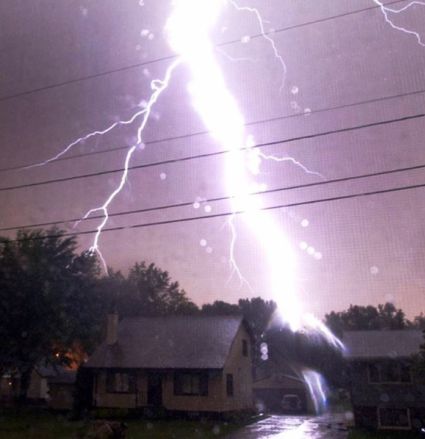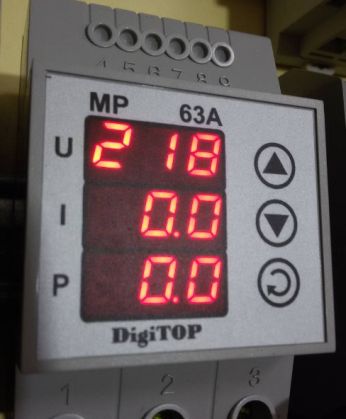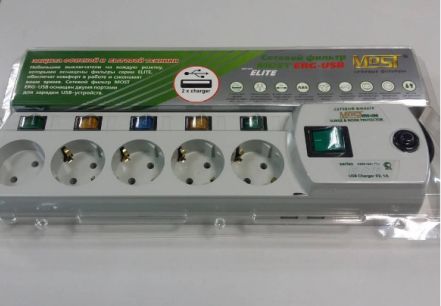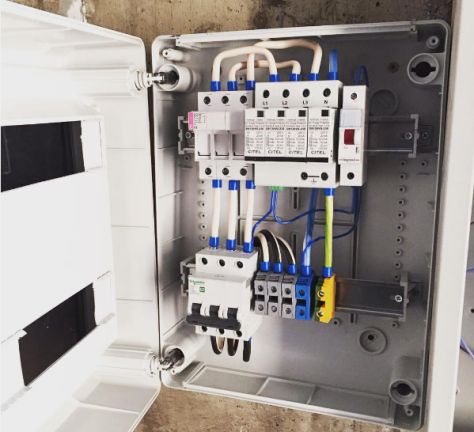Categories: Featured Articles » Electrician at home
Number of views: 31128
Comments on the article: 1
Lightning Surge Protection for Home Wiring
Thunderstorm discharge is very dangerous, since its value can reach several hundred thousand volts. After each thunderstorm, the equipment fails, the power lines are damaged, and people can also be injured. It is impossible to determine where the lightning strikes, so it is a mistake to assume that this phenomenon will bypass your home.
Lightning may never get into a particular section of the power grid and, accordingly, the danger of a thunderstorm can be underestimated. If lightning for several years has never hit a particular section of the power grid, this does not mean that such a possibility is excluded.

The occurrence of lightning overvoltage in the household electrical network in the absence of appropriate protection will lead to the failure of household electrical appliances that were included in the network at that time, and there is also a danger that residents of the house will suffer. Therefore, care must be taken to protect the home wiring from lightning surges in order to avoid possible negative consequences.
First of all, it should be noted that supplying organizations should provide surge protection by installing appropriate protective devices on power lines. But, as often happens in practice, most overhead power lines are in poor condition and do not have the proper surge protection. In this case, the issue of protecting home wiring from possible overvoltage is a problem for consumers themselves.
Modular surge arresters

Nonlinear surge arresters, the so-called arrester arresters, are used to protect electrical networks at distribution substations, as well as directly on overhead power lines.
The main structural element of these protective devices is a varistor, an element with non-linear characteristics. The non-linearity of the characteristics lies in the change in the resistance of the varistor depending on the magnitude of the voltage applied to it.
In normal operation, when the voltage is within the rated values, the voltage limiter has a large resistance and does not conduct current. In the event of an overvoltage pulse, which occurs when lightning strikes the wires of the electric network, the resistance of the arrester of the arrester drops sharply to minimum values and the unwanted pulse goes into ground loopto which a surge suppressor is connected.

Thus, the arrester limits voltage surges to a safe level, thereby protecting equipment and consumers from damage and other negative effects of overvoltages.
To implement surge protection in home wiring, there are compact modular surge arresters. Such a protective device is installed in the home switchboard and does not take up much space.
The modular SNP has the same operating principle as the limiters used in power networks. Accordingly, it will work only if there is a working grounding of the wiring. Otherwise, the installation of a modular arrester will be useless, since in the event of an overvoltage in the network, the dangerous impulse will not be limited.
That is, to implement the protection of home wiring from lightning surges with a modular surge protector, a prerequisite must be availability of efficient groundingprovided by the configuration of the electrical network or an individual grounding circuit.
Voltage relay

As for the voltage relay, as well as devices having the corresponding function (stabilizer, uninterruptible power supply, etc.), it should be borne in mind that these devices can operate within the specified operating voltage limits, their insulation is not able to withstand high voltages.
Therefore, in the event of a lightning strike, a lightning pulse will damage the voltage relay and other devices that have the corresponding function, not only fail, but also other electrical devices included in the network will be damaged, as a dangerous pulse will go further through the wiring and household appliances connected to the network.
That is, the voltage relay cannot perform the function of protection against lightning impulses. But still, this protective device must be installed in home distribution board.
The voltage relay disconnects the wiring in the event that the voltage goes beyond the permissible limits, since an excessive decrease or increase in the voltage of a household electrical network can lead to failure of household electrical appliances.
Network filters

Most network filters have a built-in varistor, that is, these devices protect the included electrical devices from power surges. Many people acquire network filter and they believe that the equipment included in it will be protected from possible voltage surges. But at the same time, in most cases, the fact that the varistor of the line filter, as in the voltage limiter, limits a dangerous surge pulse only in the presence of a working grounding of the electrical wiring, is not taken into account.
In the line filter, the varistor connects the phase or neutral conductor of the electrical wiring to the protective grounding conductor and in case of overvoltage, a dangerous pulse goes into the grounding circuit through the grounding conductor, thereby protecting electrical appliances from damage. Therefore, the inclusion of a line filter in a network that does not have a working grounding negates the protective function - household electrical appliances will not have protection and in the event of a lightning impulse will fail.
Other lightning pulse paths
Protection of home wiring from lightning impulses does not fully protect electrical appliances from lightning. Do not forget that lightning can strike not only in the wires of electric networks, but also in cable lines for other purposes, which are laid in an open way. In this case, we are talking about a network cable for the Internet, a television and telephone cable. Also, lightning can get into the antenna installed outdoors.
If lightning strikes a cable or antenna, a lightning discharge falls into the device that is connected to them. That is, we can conclude that the presence of protection of the household electrical network from lightning pulses does not exclude the ingress of dangerous pulses in another way.
Many people, when approaching a thunderstorm, immediately disconnect from the network a TV, computer or other equipment that has an external antenna or is connected to external cable networks. After a thunderstorm, turning on the equipment in the network, it turns out that it failed because of a lightning pulse through an external cable or antenna.
What protection measures exist in this case? To exclude a possible hit of a lightning pulse through the cable, you must disconnect it from the device. For example, disconnect the network cable from a computer or router, or if it is a TV, disconnect the antenna cable or cable cable.
There are also specialized lightning protection devices to protect network cables and devices from lightning discharges. But these devices are quite expensive and, accordingly, are not used in everyday life. Moreover, they may prove to be completely ineffective and may not provide protection if necessary.

In conclusion, it should be noted that getting a lightning discharge into household electrical appliances, wiring is very dangerous for people who are currently in close proximity to these electrical appliances, wiring components. If a household electrical appliance damaged by a lightning bolt can be repaired or a new one purchased, then for a person it can end in disaster.
Also, fire of equipment or electrical wiring as a result of a thunderstorm pulse is not excluded. Therefore, you can not neglect the protection of your home wiring from lightning surges, and try to disconnect network cables and external antennas whenever possible in the event of a thunderstorm approaching.
See also on this topic:Surge arresters in home wiring - types and wiring diagrams
See also at bgv.electricianexp.com
:
